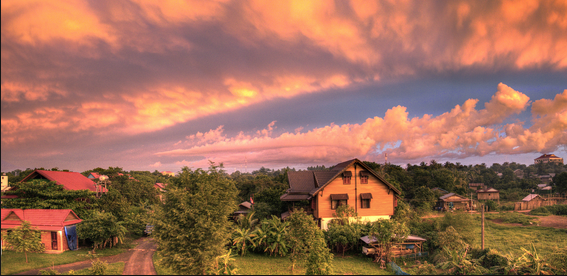Ratanakiri is an area (khaet) of Cambodia situated in the remote upper east. It fringes the areas of Mondulkiri toward the south and Stung Treng toward the west and the nations of Laos and Vietnam toward the north and east, separately. The territory stretches out from the mountains of the Annamite Range in the north, over a sloping level between the Tonle San and Tonle Srepok waterways, to tropical deciduous timberlands in the south. As of late, logging and mining have scarred Ratanakiri's surroundings, long known for its magnificence.

For over a thousand years, Ratanakiri has been possessed by the good country Khmer Loeu individuals, who are a minority somewhere else in Cambodia. Amid the locale's initial history, its Khmer Loeu tenants were misused as slaves by neighboring domains. The slave exchange economy finished amid the French pilgrim period, yet an unforgiving Khmerization crusade after Cambodia's freedom again undermined Khmer Loeu lifestyles. The Khmer Rouge assembled its home office in the area in the 1960s, and shelling amid the Vietnam War crushed the locale. Today, quick improvement in the territory is changing conventional lifestyles.
Ratanakiri is inadequately populated; its 150,000 occupants make up a little more than 1% of the nation's aggregate populace. Inhabitants for the most part live in towns of 20 to 60 families and take part in subsistence moving farming. Ratanakiri is among the slightest created territories of Cambodia. Its framework is poor, and the neighborhood government is feeble. Wellbeing markers in Ratanakiri are to a great degree poor; men's future is 39 years, and ladies' is 43 years. Training levels are likewise low, with simply under a large portion of the populace uneducated.
After the Vietnamese crushed the Khmer Rouge in 1979, administration arrangement toward Ratanakiri turned into one of favorable disregard. The Khmer Loeu were allowed to come back to their customary employments, yet the legislature gave little framework in the territory Under the Vietnamese, there was little contact between the commonplace government and numerous neighborhood groups. Long after the fall of the Khmer Rouge administration, on the other hand, Khmer Rouge agitators stayed in the woodlands of Ratanakiri. Revolts to a great extent surrendered their arms in the 1990s, however assaults along commonplace streets proceeded until 2002.
Ratanakiri's late history has been portrayed by improvement and orderly difficulties to conventional lifestyles. The national government has manufactured streets, energized tourism and farming, and encouraged quick migration of swamp Khmers into Ratanakiri. Street changes and political strength have expanded area costs, and area distance in Ratanakiri has been a noteworthy issue. In spite of a 2001 law permitting indigenous groups to get aggregate title to customary grounds, a few towns have been left about landless. The national government has allowed concessions over area generally controlled by Ratanakiri's indigenous people groups, and even land "deals" have frequently included fixes to authorities, intimidation, dangers, or deception. Taking after the inclusion of a few global non-administrative associations (NGOs), land distance had diminished in recurrence starting 2006. In the 2000s, Ratanakiri likewise got several Degar (Montagnard) exiles escaping agitation in neighboring Vietnam; the Cambodian government was condemned for its coercive repatriation of numerous outcasts
